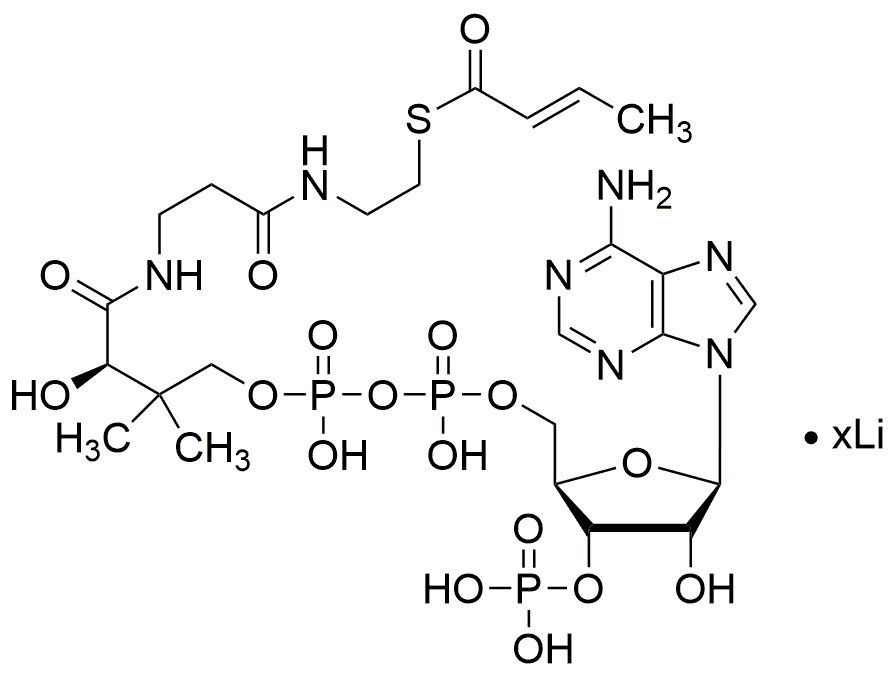2-Butenoyl coenzyme A lithium salt is widely utilized in research focused on:
- Metabolic Studies: This compound plays a crucial role in studying metabolic pathways, particularly in fatty acid metabolism and energy production, helping researchers understand cellular energy dynamics.
- Biochemical Assays: It serves as a valuable reagent in biochemical assays for enzyme activity, allowing scientists to measure the effectiveness of various enzymes in metabolic processes.
- Pharmaceutical Development: Its application in drug formulation aids in the development of therapeutics targeting metabolic disorders, providing a framework for creating more effective treatments.
- Food Industry: The compound can be used in food science research to explore flavor compounds and their interactions, enhancing the understanding of food chemistry.
- Biotechnology: In biotechnology, it is utilized in the production of biofuels and bioproducts, contributing to sustainable energy solutions and reducing reliance on fossil fuels.
Informations générales
Propriétés
Sécurité et réglementation
Applications
2-Butenoyl coenzyme A lithium salt is widely utilized in research focused on:
- Metabolic Studies: This compound plays a crucial role in studying metabolic pathways, particularly in fatty acid metabolism and energy production, helping researchers understand cellular energy dynamics.
- Biochemical Assays: It serves as a valuable reagent in biochemical assays for enzyme activity, allowing scientists to measure the effectiveness of various enzymes in metabolic processes.
- Pharmaceutical Development: Its application in drug formulation aids in the development of therapeutics targeting metabolic disorders, providing a framework for creating more effective treatments.
- Food Industry: The compound can be used in food science research to explore flavor compounds and their interactions, enhancing the understanding of food chemistry.
- Biotechnology: In biotechnology, it is utilized in the production of biofuels and bioproducts, contributing to sustainable energy solutions and reducing reliance on fossil fuels.
Documents
Fiches de données de sécurité (FDS)
La FDS fournit des informations de sécurité complètes sur la manipulation, le stockage et l’élimination du produit.
Spécifications du produit (PS)
Le PS fournit une description complète des propriétés du produit, notamment sa composition chimique, son état physique, sa pureté et les exigences de stockage. Il détaille également les plages de qualité acceptables et les applications prévues du produit.
Certificats d'analyse (COA)
Recherchez des certificats d'analyse (COA) en saisissant le numéro de lot du produit. Les numéros de lot et de lot se trouvent sur l'étiquette d'un produit, après les mots « Lot » ou « Lot de fabrication ».
Numéro de catalogue
Numéro de lot/série
Certificats d'origine (COO)
Ce certificat d'exploitation confirme le pays dans lequel le produit a été fabriqué, et détaille également les matériaux et composants utilisés et s'il est issu de sources naturelles, synthétiques ou autres sources spécifiques. Ce certificat peut être requis pour les douanes, le commerce et la conformité réglementaire.
Numéro de catalogue
Numéro de lot/série
Fiches de données de sécurité (FDS)
La FDS fournit des informations de sécurité complètes sur la manipulation, le stockage et l’élimination du produit.
DownloadSpécifications du produit (PS)
Le PS fournit une description complète des propriétés du produit, notamment sa composition chimique, son état physique, sa pureté et les exigences de stockage. Il détaille également les plages de qualité acceptables et les applications prévues du produit.
DownloadCertificats d'analyse (COA)
Recherchez des certificats d'analyse (COA) en saisissant le numéro de lot du produit. Les numéros de lot et de lot se trouvent sur l'étiquette d'un produit, après les mots « Lot » ou « Lot de fabrication ».
Numéro de catalogue
Numéro de lot/série
Certificats d'origine (COO)
Ce certificat d'exploitation confirme le pays dans lequel le produit a été fabriqué, et détaille également les matériaux et composants utilisés et s'il est issu de sources naturelles, synthétiques ou autres sources spécifiques. Ce certificat peut être requis pour les douanes, le commerce et la conformité réglementaire.


